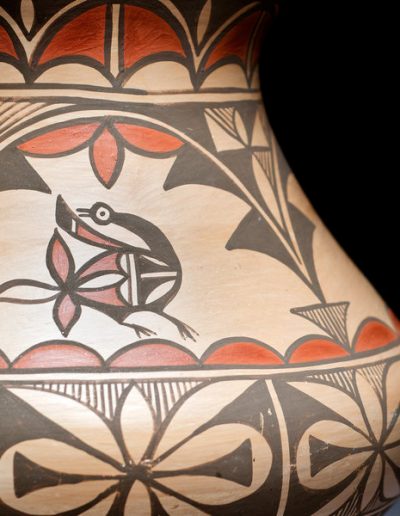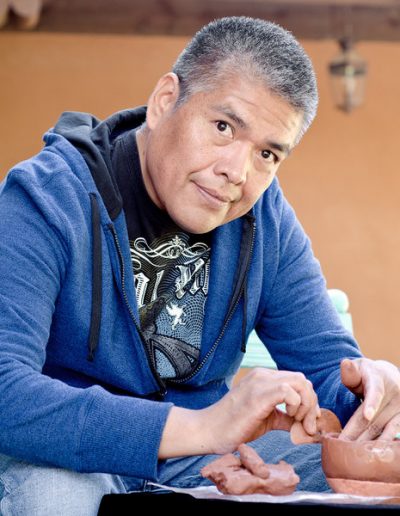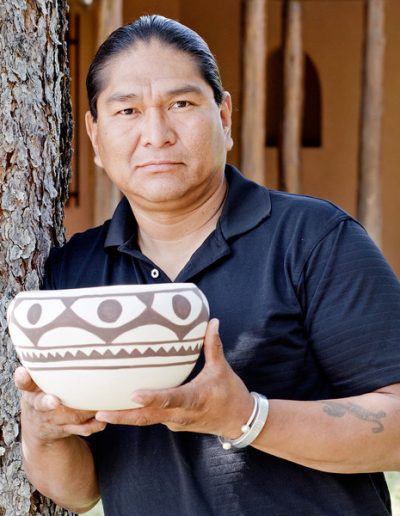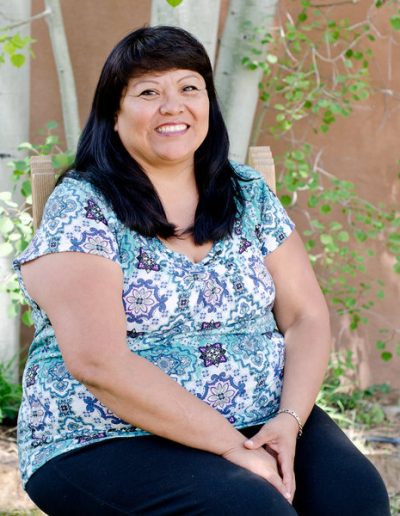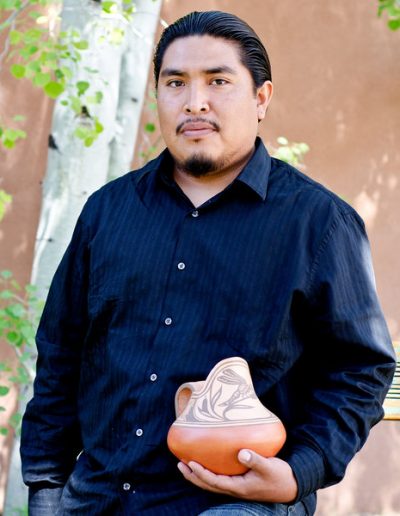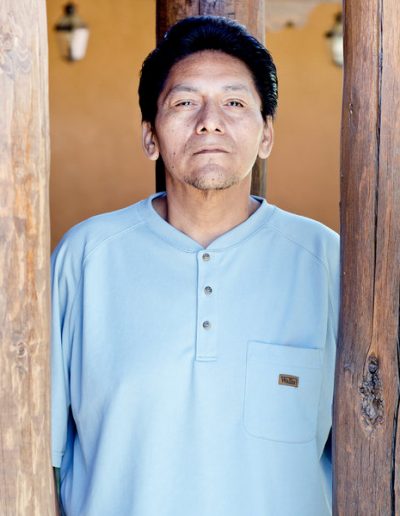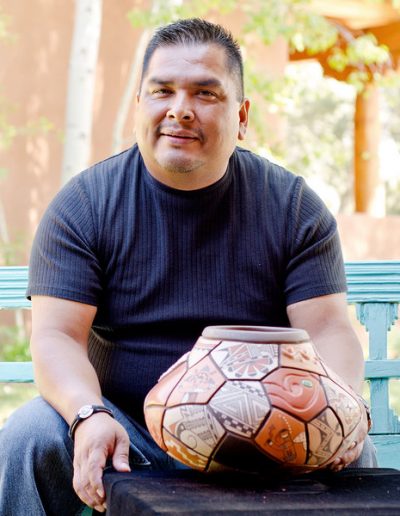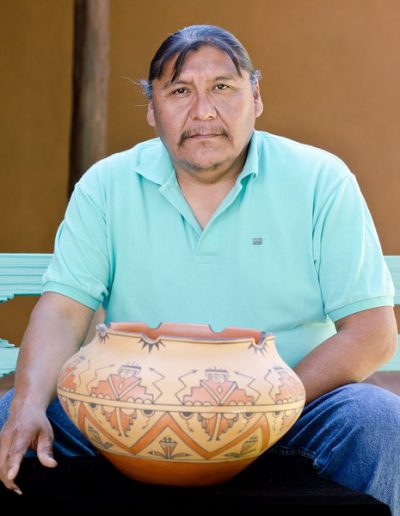May 17, 2013
The online exhibit will reside on The School for Advanced Research’s website in our Education section. In addition to highlighting the seven potters and providing contextual information about San Felipe Pueblo and pottery, IARC plans to provide viewers with an “inventory” of San Felipe pottery found in major museum collections in the U.S. This aids viewers in becoming aware of the existence of San Felipe pottery, currently and historically, since it is not widely known that San Felipe has a history and continuing tradition of pottery making.
The online exhibit is currently in development and will be completed by August 2013.
Sponsored by Anne Ray Charitable Trust
Participants
Gerren Candelaria, San Felipe Pueblo
Hubert Candelario, San Felipe Pueblo
Cynthia Chavez Lamar, Director, IARC, School for Advanced Research
Ray Garcia, San Felipe Pueblo
Joseph Latoma, San Felipe Pueblo
Geraldine Lovato, San Felipe Pueblo
Ricardo Ortiz, San Felipe Pueblo
November 11–13, 2013
For the first time, leading conservators of indigenous collections from museums across the US, Canada, and New Zealand gathered at the Indian Arts Research Center on Nov. 11–13, 2013. The group addressed timely and critical issues in the field of conservation and collections stewardship with other museum professionals, including tribal museum directors, curators, artists, and collections managers. Important changes in the field over the last twenty-five years were discussed, including the shift in conservation priorities and approaches to indigenous collections. Greater access to collections for source communities have become paramount and integral to the conservation process.
During the seminar, it was acknowledged that as a result of these changes, a collaborative model of conservation has emerged as a shared goal in the documentation, conservation decision-making, and treatment of indigenous collections. Current issues surrounding this work were discussed, including the question of how the work is carried out and with whom, and how knowledge gained as a result of collaborative work is organized and made accessible to source communities and others. The challenge of educating young conservators in a collaborative conservation model was also discussed, as well as the need for exposure and opportunities in the field of conservation and collections care for Native students. In sum, the IARC seminar offered participants an important opportunity to take stock of the current state of the field as well as to consider its future directions.
A second seminar will be held in the spring 2014 with possible outcomes of the seminar series to be discussed and developed.
Participants
As an intern at IARC, Trish works in collection care, management, educational programming, and community outreach. She is also embarking on her own independent research project about the collaboration and involvement of Native communities in the use of museum objects, examining the exchange of information that takes place between SAR, Native communities, and artists, and how that information changes knowledge about and the use of IARC collections.
Dawn Biddison, who has called Alaska her home for nearly twenty years, is assistant curator at the Alaska office of the Smithsonian Arctic Studies Center. She worked collaboratively with Alaska Native elders, tribal representatives, scholars, and artists on the website Sharing Knowledge and the exhibition Living Our Cultures, Sharing Our Heritage: The First Peoples of Alaska. She is also currently project coordinator for the exhibition Dena’inaq’ Huch’ulyeshi: The Dena’ina Way of Living at the Anchorage Museum. Through public programs, including language workshops, artists’ residencies, and monthly lectures, Dawn continues her work with Alaska Native communities.
Dawn earned her BA at Columbia University and University College London, where she pursued a cross-cultural emphasis to her study of psychology. She received an MA in anthropology at the University of Alaska Fairbanks, where her thesis was on contemporary Alaskan Native art.
Tony Chavarria is the curator of ethnology at the Museum of Indian Arts & Culture/Laboratory of Anthropology (MIAC/LAB) in Santa Fe, New Mexico. A graduate of the University of Colorado at Denver, he was the first Branigar intern at the School for Advanced Research in Santa Fe. Tony has served as secretary and board member for the Council for Museum Anthropology and as a board member for the Committee on Practicing, Applied and Public Interest Anthropology, both sections of the American Anthropological Association. He has contributed to the publications A River Apart: The Pottery of Cochiti and Santo Domingo Pueblos, Painting a Native World: Life, Land and Animals, and Here, Now and Always: Voices of the Native Southwest. Among the exhibitions he has curated are the traveling exhibition Comic Art Indigene and Heartbeat: Music of the Native Southwest. He also served as a community liaison and curator for the inaugural Pueblo exhibition at the National Museum of the American Indian in Washington, DC. He resides and abides at Santa Clara Pueblo.
Miriam Clavir received her Honours BA in anthropology from the University of Toronto, a master of art conservation from Queen’s University, and a doctorate from the University of Leicester, Department of Museum Studies. She has worked as a conservator of collections at the Royal Ontario Museum for Parks Canada, and was the conservator and then senior conservator at MOA, the Museum of Anthropology at the University of British Columbia for almost twenty-five years. During this time she authored many conservation articles for her profession and the public. Currently, she is a research fellow at MOA. In 2002, UBC Press published her scholarly book, Preserving What is Valued: Museums, Conservation and First Nations. In addition, Miriam began to write fiction after she retired from her daily conservation work at MOA. In 2012, Bayeux Arts published her first mystery novel, Insinuendo: Murder in the Museum. Her first literary short story, “Knowing Home,” was published in the fall of 2012 by The Antigonish Review.
Martina Dawley (Hualapai/Navajo) is completing a PhD in American Indian Studies, with a focus in museum studies, at the University of Arizona. She was recently hired at the Arizona State Museum (ASM) to manage the American Indian Relations program. Upon completion of her dissertation, she will advance to a faculty position at ASM. Her dissertation research specifically focuses on finding out how many American Indians are professional conservators and investigating the factors that determine this number. She was awarded scholarships from the Indigenous Material Institute and the Hualapai Department of Education. She earned her MA in American Indian Studies (2009) and her BA in anthropology with a minor in geology (2006) at the University of Arizona. She became interested in museums, especially the field of conservation, while working at ASM as a McNair Scholar (2006–2008).
Laura Elliff has been the collections manager at the Indian Arts Research Center of the School for Advanced Research since 2008. Originally from Oklahoma and a member of the Choctaw Nation, Laura has worked in the museum field since 2004 with passions for both collections care and working with local tribal communities on collaborative projects. Previously, she worked at the Center of Southwest Studies (CSWS) at Fort Lewis College in Durango, Colorado. She has a BA in anthropology; a graduate certificate in “Museum Collections Management and Care,” and an MA in American Studies.
Jim Enote – Zuni farmer and interrupted artist, Jim Enote is a man of many interests, skills, endeavors, and accomplishments.
Jim is the director of the A:shiwi A:wan Museum and Heritage Center in Zuni, New Mexico, and the director of the Colorado Plateau Foundation. He serves on the boards of the Grand Canyon Trust and Jessie Smith Noyes Foundation and is a senior advisor for Mountain Cultures at the Mountain Institute. He is a National Geographic Society Explorer; a New Mexico Community Luminaria; and an E.F. Shumacher Society Fellow.
In 2013, he received the Guardian of Culture and Lifeways Award from the Association of Tribal Archives, Libraries, and Museums, and in 2010, during the American Anthropological Association’s annual meeting, was awarded the first Michael Ames Prize for Innovative Museum Anthropology.
Born in Zuni, New Mexico, he is still camped out there at his work-in-progress home.
Sven Haakanson is associate professor in the Department of Anthropology at the University of Washington and curator of Native American anthropology at the Burke Museum. He is a member of the Old Harbor Alutiiq Tribe in Kodiak Island, Alaska, and his research centers on documenting and preserving the language and culture of the Alutiiq. Dr. Haakanson focuses on making collections more accessible to Native communities by researching objects in the world’s museums and developing traveling exhibits, educational programs, and resources. He previously served as the executive director of the Alutiiq Museum in Kodiak, Alaska, and received a MacArthur Fellowship in 2007. As an anthropologist, Dr. Haakanson is currently leading a large-scale study of sacred Alutiiq sites to identify and archive petroglyphs and stone carvings from the southern coast of Kodiak Island. He holds a PhD and an MA in anthropology from Harvard.
John Garcia (Santa Clara Pueblo) sharing his experience and knowledge about moccasin making with the seminar participants.Marian A. Kaminitz has served as the head of conservation at the National Museum of the American Indian, Smithsonian Institution, since 1991. Her main interests include conservation partnerships with Native American community artists. She was assistant conservator in the anthropology department at the American Museum of Natural History, New York, from 1985–1991. From 1988–1998 she was an adjunct professor of conservation at New York University’s Conservation Center, teaching a course in the conservation of organic ethnographic and archaeological objects. She received an MS in the conservation of artistic and historic works from the University of Delaware/Winterthur Museum Program in art conservation in 1984. She was an Andrew W. Mellon Fellow at the Pacific Regional Conservation Center, Bishop Museum in Honolulu, Hawaii, from 1984 to 1985. She served as the coordinator for the Ethnographic Working Group of ICOM-CC from 1999–2005 and is currently an assistant coordinator.
Judith Levinson is currently the director of conservation at the American Museum of Natural History in the Division of Anthropology. Until recently, she also taught conservation to graduate students in the conservation program at New York University. Before becoming a conservator, she studied anthropology as an undergraduate student, where she was first exposed to conservation at the University of Pennsylvania. She became seduced by the materials and cultures she was studying and pursued a career as a potter for several years. One thing led to another and she eventually found her way back to conservation, as a way to combine her interests in material culture, anthropology, art history, and fine arts.
Kelly McHugh is an objects conservator at the National Museum of the American Indian (NMAI). She began working for the museum in 1996 in New York, based at the museum’s former storage facility in the Bronx. There she participated in a survey of the over 800,000 objects in NMAI’s collection, prior to the collections move to the Cultural Resources Center (CRC) in Maryland. She currently cares for the collection and works to prepare objects for exhibits at NMAI-DC and NMAI-NY at the CRC. She specializes in evolving the conservation department’s collaborative conservation methodology and in caring for the museum’s contemporary art collection.
Nancy Odegaard
Nancy is the head of the preservation division at the Arizona State Museum on the campus of the University of Arizona and is a professor with the Department of Material Science & Engineering, the School of Anthropology, and the Drachman Institute (historic preservation). She leads the effort to preserve the collections of the museum through loans, exhibits, excavations, research, storage, and repatriation. Nancy also teaches student, provides outreach services, conducts research related to conservation, and has had major projects involving pottery, human remains, basketry, textiles, and pesticide residues.
Born in Minnesota, Nancy was raised in Arizona, and studied for a BA in California with a year abroad in Paris. After some work in museums, she completed an MA at George Washington University and the Smithsonian in Washington, DC, and later a PhD in Australia. She gained early conservation experience at the Los Angeles County Museum of Art, Museo Ixchel in Guatemala, Smithsonian Museum of Natural History, and the Peabody Museum at Harvard. She has been a Fulbright Scholar (1991, 2001), Winterthur Research Fellow (2000), and Getty GCI Scholar (2007). She is a fellow of the American Institute for Conservation and the International Institute for Conservation. She is the recipient of a US Department of Justice Commendation Award (2000), AIC Keck Award (2009), and the AIC Advocacy Award (2013).
Sylvanus Paul is the collections assistant at the Indian Arts Research Center of the School for Advanced Research in Santa Fe, NM. He is from Pine Hill, NM, of the Ramah Navajo Reservation. Sylvanus attended Diné College in Tsaile, AZ, with a focus on Diné Studies. He is an alumnus of Fort Lewis College in Durango, CO, with a major in American Indian Studies and a minor in Southwest History. Sylvanus has interned at Mesa Verde National Park, where he trained on maintaining the longevity of their archaeological items. He continued to work for the park service with collections care for Chaco Canyon Historical Park.
Ellen Pearlstein is an associate professor at the University of California, Los Angeles, teaching in information studies and in the UCLA/Getty Program in Archaeological and Ethnographic Conservation. In her latter capacity, Ellen is presently working with weavers in southern California, the Agua Caliente Cultural Museum in California, and the Hibulb Cultural Center in Tulalip, WA, involving the weavers in graduate conservation education. Her research interests include American Indian tribal museums and how museum staff defines cultural preservation; effects of environmental agents on ethnographic and natural history materials; introducing context into cultural materials’ conservation education; and curriculum development. She is co-director of the UCLA and Getty Conservation Institute feather research project.
Gary Roybal is retired after twenty-five years as Native American Liaison and Museum Curator at Bandelier National Monument, New Mexico. He was previously assistant curator at the Museum of Indian Arts and Culture and was a School for Advanced Studies intern for one year in conservation, security of collections, and collections management. Gary has served three separate terms as Lt. Governor at San Ildefonso Pueblo and one two-year term as Head War Captain and Assistant War Captain of San Ildefonso. He learned to make moccasins from his grandfather, Juan Cruz Roybal, over thirty years ago and has been making them since then. He primarily makes traditional pueblo style moccasins. Gary has participated in SWAIA’s Indian Market and the New Mexico State Fair. He has taught moccasin making to adults at the Poeh Museum arts and crafts program at Pojoaque Pueblo.
Melvin Sarracino is from the Pueblo of Laguna. He attended the Institute of American Indian Arts, beginning in the fall of 2006 and graduated with a BA in museum studies in May of 2009. Later that year, the Acoma Business Enterprises hired him as the Museum Specialist at the Sky City Cultural Center & Haak’u Museum at Acoma Pueblo. At the museum, he has helped to carry out exhibit installations and de-installations, conducted community outreach with guided tours for youth and adults, and has utilized the best-known methods for collections care.
Melvin is a member of the American Association for State and Local History and the Indian Advisory Panel at the Museum of Indian Arts and Culture/Laboratory of Anthropology. He also completed a nine-month Anne Ray internship with the Indian Arts Research Center at the School for Advanced Research in Santa Fe for 2012–13.
Landis Smith (Seminar Co-Chair) is currently Conservator, Museums of New Mexico Conservation Unit, Santa Fe, NM, and Research Associate, National Museum of the American Indian Conservation Department. She was previously Anchorage Project conservator at the Smithsonian National Museum of Natural History; project conservator at the Museums of New Mexico; and conservator at the Department of Anthropology, American Museum of Natural History, New York. Landis currently serves on the Board of Trustees for the Haak’u Museum at Acoma Pueblo. Since 1989, much of her career has been focused on ways to carry out collaborative documentation and other conservation work with indigenous artists, elders, tribal leaders, scientists, and other experts. Her work includes the development and organization, in collaboration with the National Museum of the American Indian, of a community-based educational program in New Mexico for NMAI conservation fellows, interns, and staff. Areas of collaborative research include Pueblo pottery, Southwest Native silver jewelry, and Alaska Native material culture.
Rangi Te Kanawa (B.Sc, M.Sc) is a textile conservator at the Te Papa Tongarewa in New Zealand and managing director of Muka Ltd. Her background in textiles derives from her childhood tuition in traditional Maori weaving by her mother, the late Diggeress Te Kanawa, and her grandmother, the late Dame Rangimarie Hetet. Rangi’s experience includes conservation treatment of historical and contemporary Maori, European, and Pacific textiles.
Rangi provides advice on the installation and de-installation of textiles for exhibition and storage, care and handling of textile collections, as well as presentations on Marae and Museums, through lectures and workshops on preventative conservation practices of textile collections and storage systems.
Rangi is engaged in continual research on conserving textiles, specializing in the stabilization of traditionally dyed black- iron/tannate fibre in Maori textiles. She has contributed to the Maori Colourants and Auxiliary Dyes research programs, Victoria University, Wellington; and DNA research with Allan Wilson Centre, Institute of Molecular Biosciences Albany campus, Massey University.
Jordan Wilson is from the Musqueam Indian Band and is a descendant of the hən̓q̓əmin̓əm-speaking peoples of the Lower Fraser River near Vancouver, British Columbia. He is an Anne Ray intern at SAR and a second year graduate student in the Master of Arts program in anthropology, museum studies stream, at the University of British Columbia (UBC). Jordan participated in the collections-based Smithsonian National Museum of Natural History’s Summer Institute in Museum Anthropology program and also spent a term abroad at the University of Tromsø in northern Norway, taking indigenous studies courses and visiting museums across arctic Scandinavia.
Jordan feels his first responsibility is to become an indigenous scholar, hoping to contribute to the betterment of his own community of Musqueam, as well as the larger indigenous community. Perceiving museums as powerful outlets for positive change, Jordan will integrate his background in indigenous studies with museum work, as well as meeting and exchanging ideas with others who share a similar outlook.
Cynthia Chavez Lamar, Facilitator
Landis Smith, Facilitator
Trish Baudino
Dawn Biddison
Tony Chavarria
Miriam Clavir
Martina Dawley
Laura Elliff
Jim Enote
Sven Haakanson
Marian A. Kaminitz
Judith Levinson
Kelly McHugh
Nancy Odegaard
Sylvanus Paul
Ellen Pearlstein
Gary Roybal
Melvin Sarracino
Rangi Te Kanawa
Jordan Wilson

Conservation seminar participants: (left to right, front row) Martina Dawley, Gary Roybal, Marian Kaminitz, Judith Levinson, and Cynthia Chavez Lamar; (left to right, back row) Sven Haakanson, Nancy Odegaard, Tony Chavarria, Landis Smith, Rangi Te Kanawa, Ellen Pearlstein, Laura Elliff, Kelly McHugh, Dawn Biddison, Patricia Baudino, Sylvanus Paul, Melvin Sarracino, Jordan Wilson, and Miriam Clavir.
